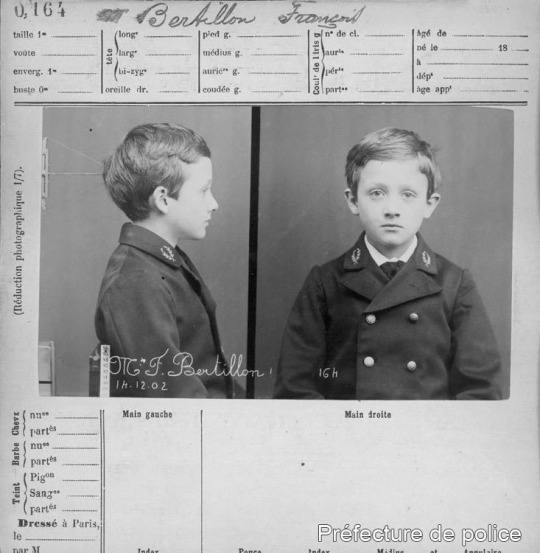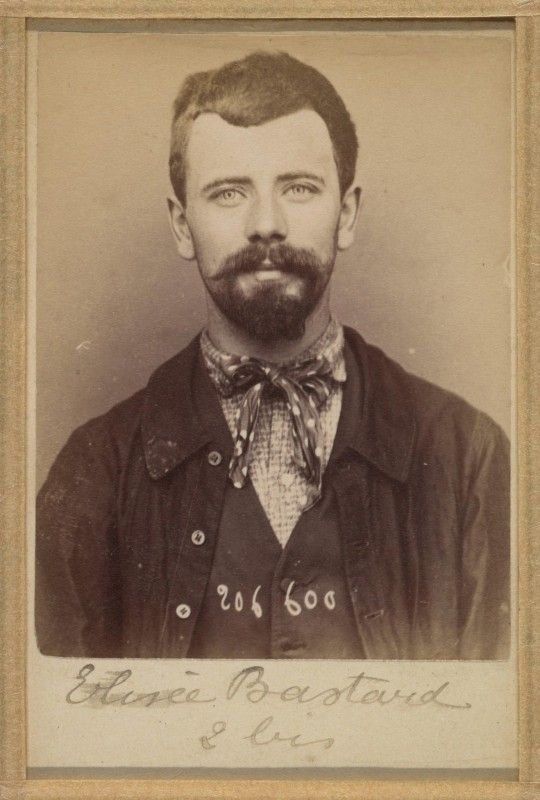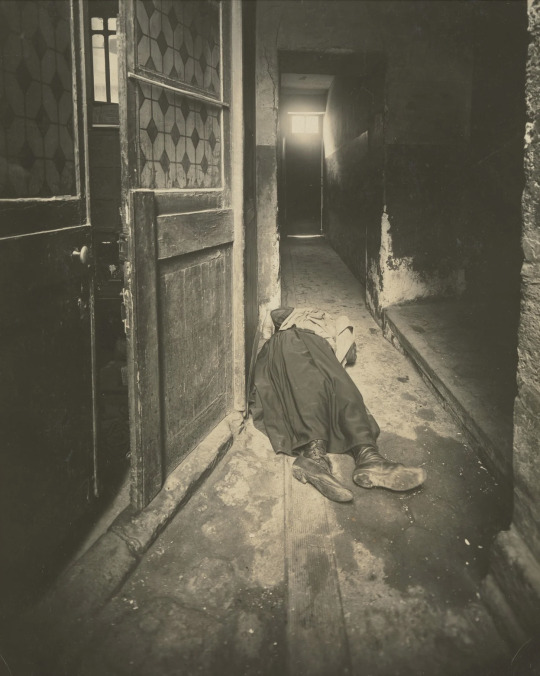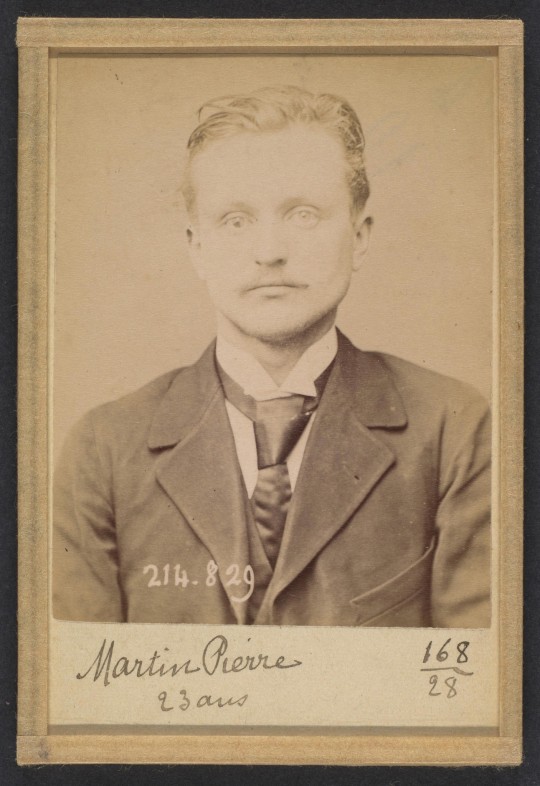#alphonse bertillon
Text
Earprint: A Unique Form Of Forensic Evidence
Continue reading Earprint: A Unique Form Of Forensic Evidence

View On WordPress
#alphonse bertillon#biometrics#ear print as an evidence#ear prints#ear prints at crime scene#earmarks#forensic science ear print
3 notes
·
View notes
Text
WHOO!

I get to teach Forensic Sciences again next semester! With a prof I really like and have previously TA’ed for! It’s a super fun course - Intro to Criminalistics - so it’s a little bit of everything. Prints, bones, blood, DNA, drugs, mapping, and more. She’s also researching Forensic Anth, so we can dork out about bones.
AND I’m teaching Crim Theory, too, which is a designated writing-intensive course. I have not worked with the prof for this course, but I hear she’s awesome. Not only do I get to dive into the history of Criminology again, but go absolutely ham on essay-writing technique and tips. (YOU WILL LEARN TO STACK AN ARGUMENT. I can’t guarantee you will learn to love APA, but you will come to grips with it and develop a personalized checklist with samples of in-text citations and title page contents, in order.)
Lesson 1: Who Are You? (Who who? Who who?)

[Text ID: An antique parody of a double mug shot, in sepia tones. A 23-month-old infant with curly light hair sits in a plain wooden high chair, a winsome expression on his face. He is dressed in a typical child’s white frock of the period with a frilled collar, sleeves and skirts. The first panel is in profile, with the child facing right. The second panel is face-on. The inscription reads: François Bertillon, âgé de 23 mois. 17 - oct - 93.]
This infantile mug shot, now in the MOMA collection, is commonly known as: “François Bertillon, 23 months (Baby, Gluttony, Nibbling All the Pears from a Basket)”
Alphonse Bertillon, a French police officer from the late 1800s, sought to revolutionize criminal identification by statistical means. He developed a system, which he called Bertillonage, of body measurements - anthropometry - that could be tabulated and compared with others, under the assumption that no two people would share the exact same measurements.
Now, this idea was an offshoot of biological determinism, a theory that the body itself predicted behaviour and the state of the mind. Biological determinism was actually a revolution in its day: it represented a split from the previous belief that aberrant behaviour and physical infirmity were proof of demonic influence and a directly-involved God. However, biological determinism, itself an offshoot of Platonic essentialism, led to such notions as Lombroso’s “atavistic”-bodied criminal with a hulking body, a lowered brow and a “stupid stare”, as well as pseudo-science parlour fun like phrenology. Not to mention the blatant eugenicism and superior-more-developed-race blather that still persists in many branches of social sciences.
But two hundred and some years into the European Enlightenment, empirical science was moving slowly towards the acceptance of provable, testable hypotheses based in reason and repetition. So Bertillon reasoned that, if you went about the task scientifically, with enough detail, you ought to be able to prove that no two people had the same bodies, and could therefore be told apart. (And just maybe prove that you could tell a criminal from looking at them.)
But no. The collection of Bertillonage data was incredibly painstaking. Subjects had to have a long series of measurements taken, in the exact same postures, using the same equipment. Then, the subjects were required to have photographs taken, from specific angles: the first mug shots. Bertillion spent years perfecting his photographic system. The above photos of his little nephew François are just one example of Bertillon bringing his whole family into the process - an excuse to combine his work with his hobby of photography and his love of his close-knit family.
(Note the implication here: “My family is the control group, the ideal specimens. Normal people look and behave like us.” When thinking about data, always ask yourself: who’s taking the photographs? Who’s collecting the samples, and from where, and how, and why those samples in particular?)
Bertillonage didn’t take off. People have too many similarities as well as differences, and the human error involved in the measurements and photography was too great. But he did create a stunning longitudinal study of his family and friends over a couple of decades, as well as of local criminals. Here’s François a few years later. Can you see details that persist through out his aging? How would you describe them?

You can see here some of the prescribed measurements in the Bertillonage system - and they didn’t have spreadsheets to look up and compare cases!
Bertillon’s underlying idea had merit. No two people are exactly alike. Even identical twins develop epigenetic differences over time. Fingerprints form in the womb, with randomized development due to the uterine environment. We can only measure these things with technical tools - low tech like magnifying glasses, high tech like digitized pattern recognition and molecular amplification. But we’ll get to that later.
Before you leave! Your homework this week is to write a description of yourself that is detailed enough that it would help investigators identify your remains. Under 500 words please. Point form is fine. Post to Canvas by midnight Sunday.
23 notes
·
View notes
Photo

o tripé de alphonse bertillon, com mais de dois metros de altura
0 notes
Text

Mucha, bronze sculpture "La Nature" (1899-1900). Produced for the 1900 Paris World Exposition. Five of them, including the original, have been confirmed. Collection of the Royal Museums of Fine Arts of Belgium. It is also housed in the Alphonse Mucha Museum in Sakai, Osaka.
3 notes
·
View notes
Text
from the nineteenth-century French criminologist Alphonse Bertillon:
“The eye only sees in each thing that for which it looks, and it only looks for that of which it already has an idea.”
This makes human vision not unlike computer vision in that it also relies on the identification of patterns ..
#perception#Alphonse bertillon#psychology#philosophy#history#perspective#mindfulness#higher consciousness
0 notes
Text

Mugshot of the Inventor of the Mugshot
Alphonse Bertillon
1912
#Alphonse Bertillon#photography#mugshot#Inventor of the Mugshot#1912#Mugshot of the Inventor of the Mugshot
83 notes
·
View notes
Text

Mugshot of Élisée Bastard, butcher's assistant then polisher, anarchist.
22 years old / 1m67.7 (5'6) / brown hair.
Born in 1871, in Birnel (Oise, France). Died in 1957.
Cornerstone of Saint-Denis' anarchist group and described by the police as very militant.
Taken by Alphonse Bertillon on August 28th 1893.
#19th century#1890s#1800s#alphonse bertillon#gilded age#antique#antique portrait#antique photography#belle epoque#victorian era#19th century fashion#19th century photography#history#history geek#history nerd#old photography#victorian fashion#victorian photography#old photograph#late 19th century#history lover#history crushes#history crush#victorian boyfriend#victorian#belle époque#anarchist#anarchism#anarchy
316 notes
·
View notes
Text
Alphonse Bertillon
Bertillon was born in the French capital of Paris. He was the younger brother of statistician and demographer Jacques Bertillon and the son of statistician Louis-Adolphe Bertillon. Alphonse Bertillon grew up in a scientific family. His...
#forensicsc
(more…)

View On WordPress
#1879 alphonse bertillon#alphonse bertillon#alphonse bertillon anthropometry#alphonse bertillon biographie#alphonse bertillon biography#alphonse bertillon books#alphonse bertillon contribution#alphonse bertillon contribution in photography#alphonse bertillon contribution to fingerprints#alphonse bertillon contribution to forensic science#alphonse bertillon contribution to forensic science date#alphonse bertillon contributions#alphonse bertillon created the first#alphonse bertillon developed a method of criminal investigation#alphonse bertillon develops system to identify people using body measurements#alphonse bertillon discover#alphonse bertillon father of#alphonse bertillon fingerprints#alphonse bertillon forensic photography#alphonse bertillon forensic science#alphonse bertillon forensics#alphonse bertillon in america#alphonse bertillon invents the modern mug shot#alphonse bertillon is known for#alphonse bertillon met museum#alphonse bertillon photography#alphonse bertillon system#alphonse bertillon table#alphonse bertillon used phtography to#alphonse bertillon was responsible for creating the first
1 note
·
View note
Photo

[Album of Paris Crime Scenes] 1901–8 - Metropolitan Museum ...
Attributed to Alphonse Bertillon
Alphonse Bertillon, the chief of criminal identification for the Paris police department, developed the mug shot format and other photographic procedures used by police to register criminals. Although the images in this extraordinary album of forensic photographs were made by or under the direction of Bertillon, it was probably assembled by a private investigator or secretary who worked at the Paris prefecture. Photographs of the pale bodies of murder victims are assembled with views of the rooms where the murders took place, close-ups of objects that served as clues, and mug shots of criminals and suspects. Made as part of an archive rather than as art, these postmortem portraits, recorded in the deadpan style of a police report, nonetheless retain an unsettling potency.
29 notes
·
View notes
Text


Clotilde Adnet, 19, 1894. Via x
6 notes
·
View notes
Photo

fotografia métrica para cenas de crime, alphonse bertillon
0 notes
Photo

Alphonse Bertillon. Portrait présumé de George et François Bertillon, 1891
.
47 notes
·
View notes
Text

Mugshot of Pierre Martin, salesman, anarchist.
22 or 23 years old, 1m69.6 (5'6.5), light blond hair.
Born in 1871, in Saint-Léger-sur-Dheune (Saône-et-Loire, France). Died in 1947.
Taken by Alphonse Bertillon, February 27th 1894, Paris.
#alphonse bertillon#19th century#1890s#19th century fashion#19th century photography#history#victorian era#history crush#history geek#history nerd#old photography#gilded age#antique#antique portrait#antique photography#belle epoque#belle époque#old photograph#victorian photography#victorian fashion#fashion history#late 19th century#history lover#history crushes#victorian boyfriend#victorian#mugshot#french history#heterochromia#anarchist
12 notes
·
View notes
Text
Crime-Scene Photos Are Lizzie Borden’s Legacy
Crime-Scene Photos Are Lizzie Borden’s Legacy
[ad_1]
The faded images of a couple hacked to death on August 4, 1892, are some of the most chilling crime-scene photographs in American history. One victim, Andrew Borden, is shown sprawled at an awkward angle on a chaise longue. His face looks like it’s been scratched off the photograph by a jilted lover, but in reality, savage blows to the head left the 69-year-old man almost entirely…
View On WordPress
#Abby Borden#Alphonse Bertillon#Andrew Borden#art#arts#Bridget Sullivan#Crime#Entertainment#essay#general news#Jack the Ripper#legal action#Lizzie Borden#manslaughter#murder#photography#political
0 notes

